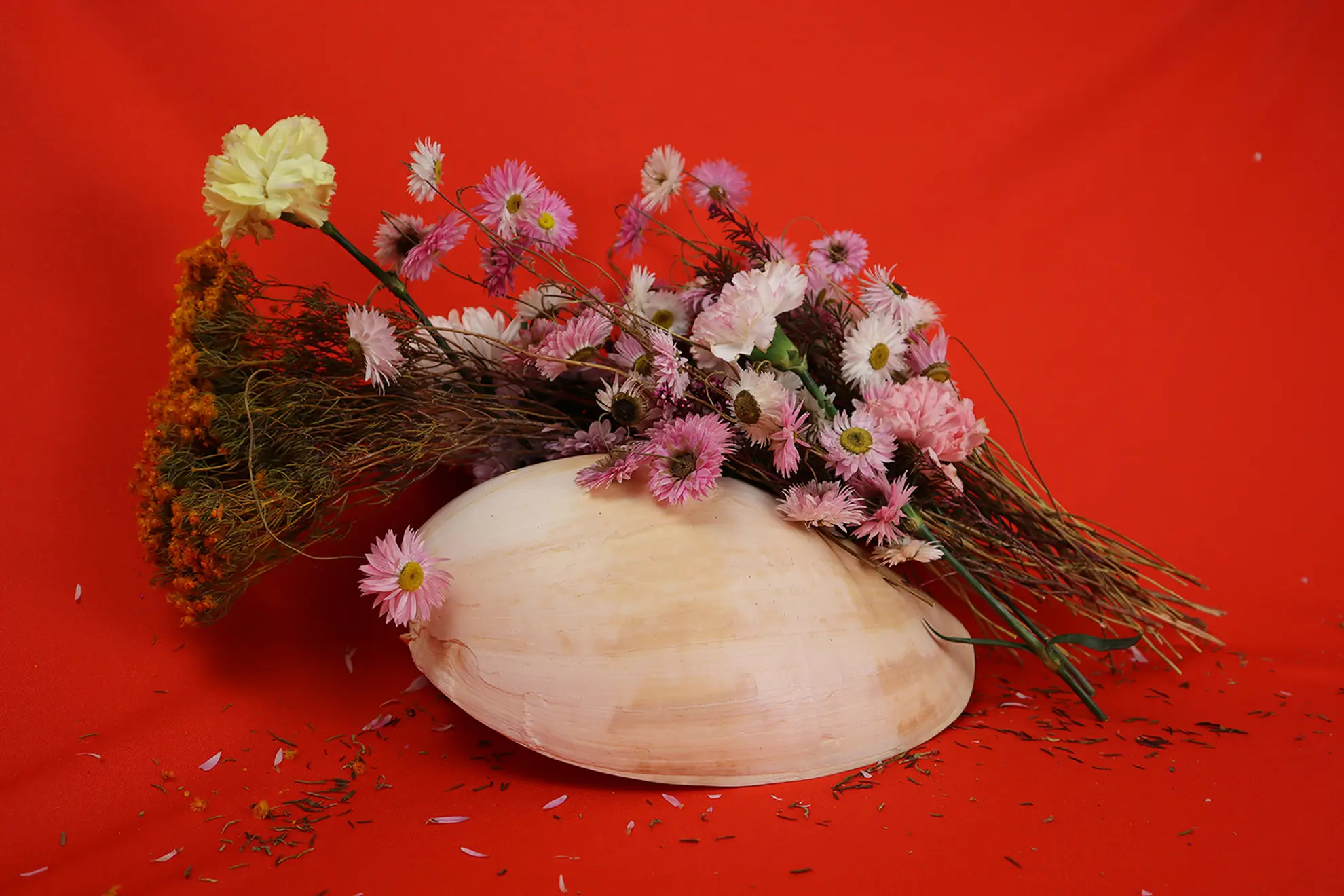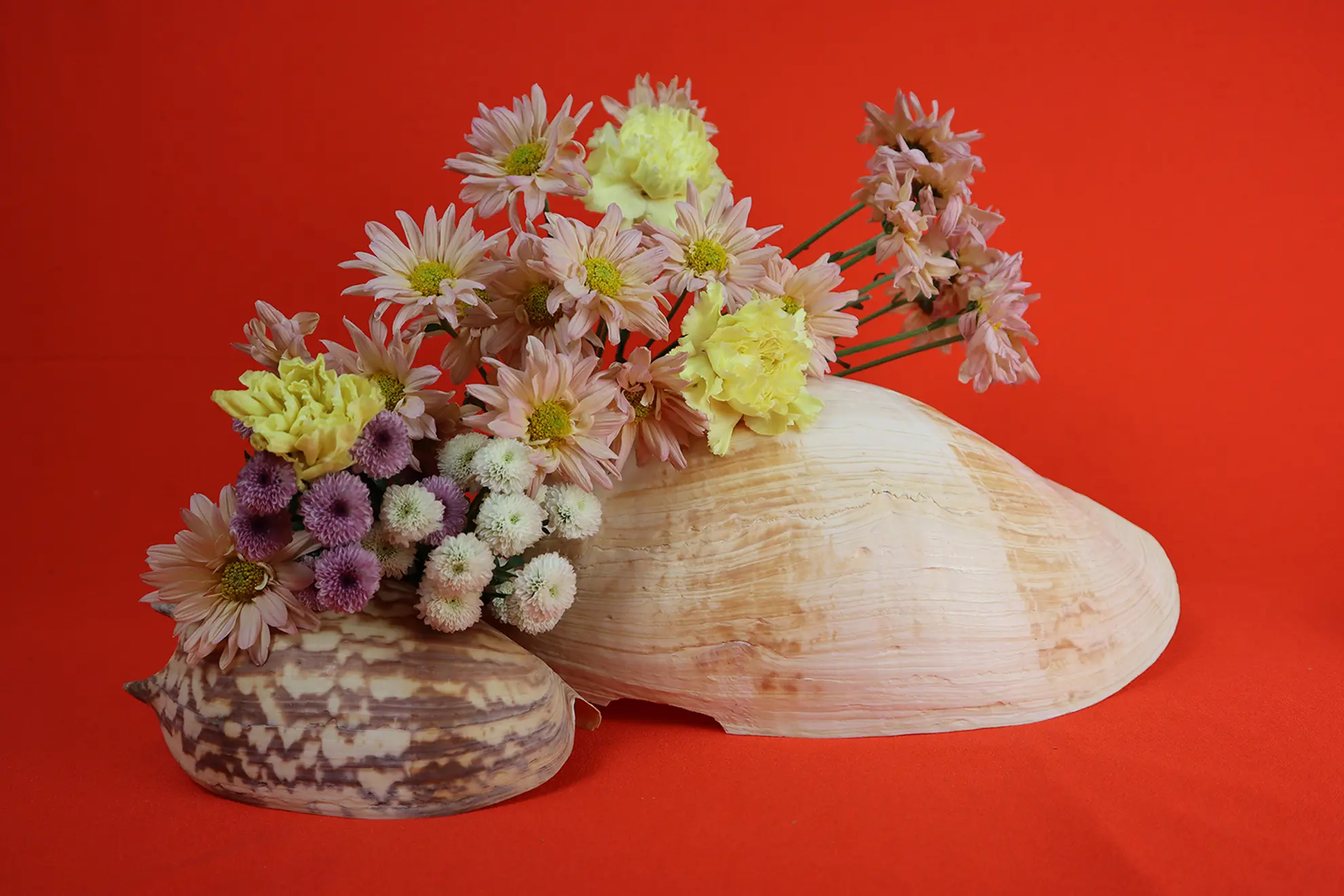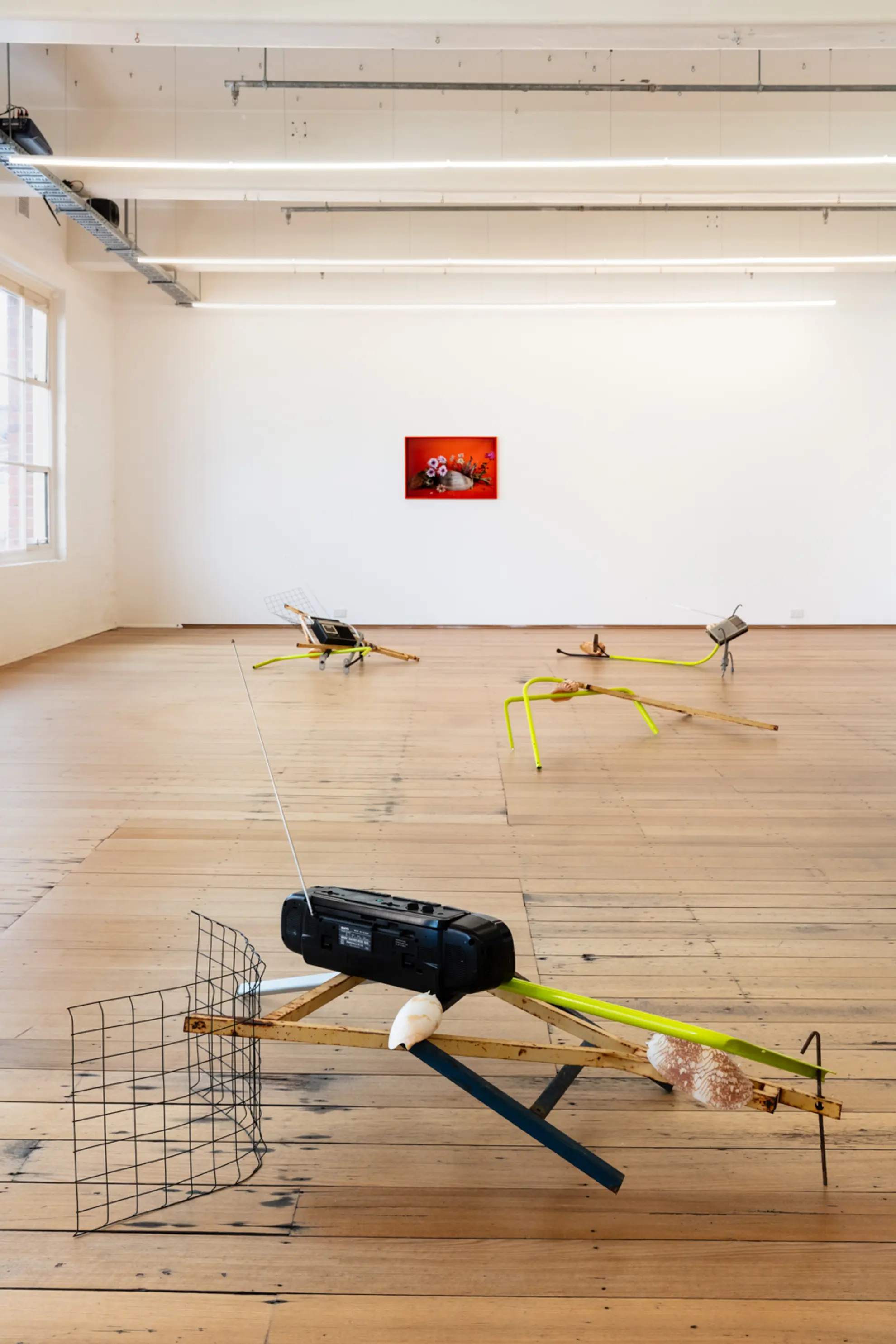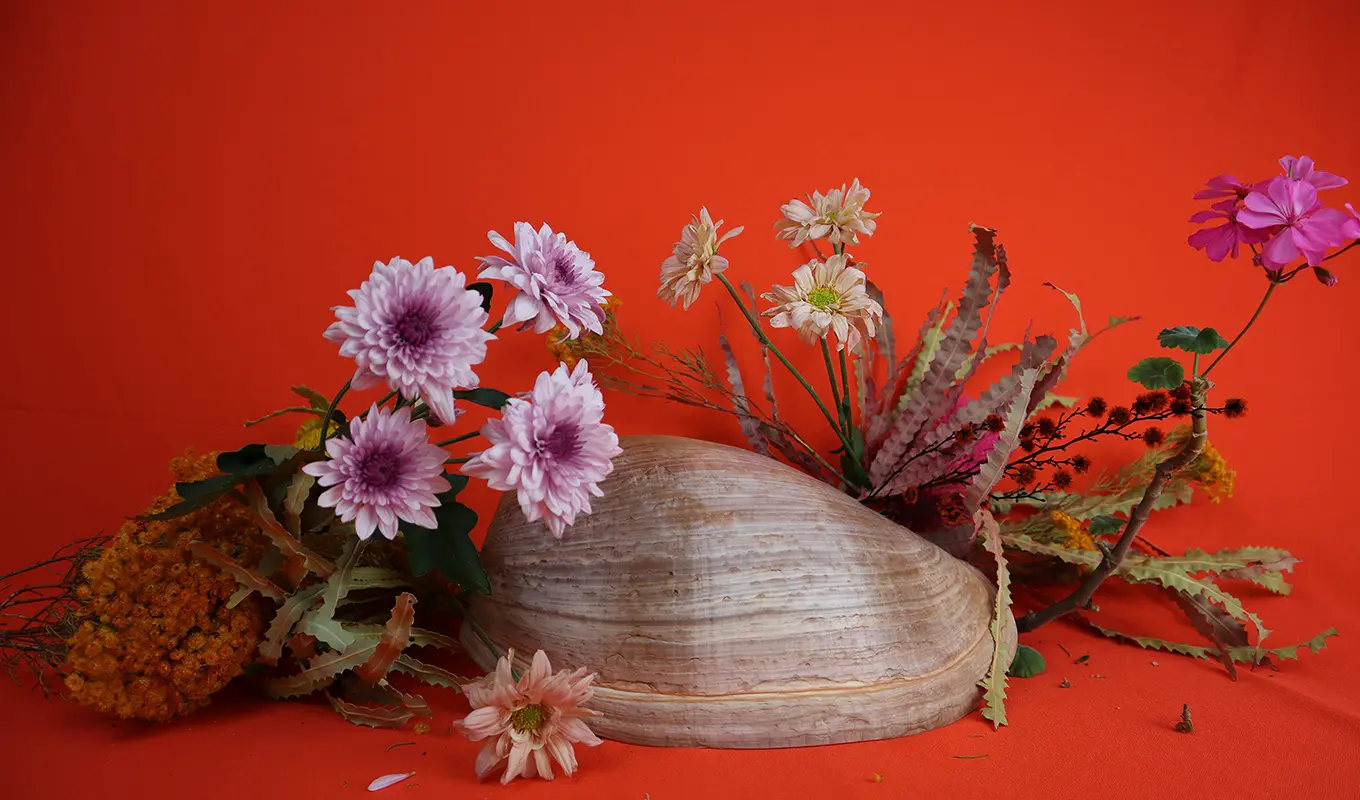Fayen d'Evie
“Rockpools”
Sunlight glinting across a tidal rockpool on Ngarluma country. Glare laces the image with flares of green. The surface of the pool mirrors the sky: billowing grey clouds, gathering. The sky image ripples, stirred by the wind maybe, or the incoming tide, or the outgoing tide, or creatures crawling, darting, grazing.
The rocks are striped grey and pink and green and white: time compressed into sedimented layers. Craggy spires cast shadows across the surface of the pool. With the reflections of the clouds held at bay, the life world of the pool basin dances into view. Seaweed like pale lace, delicate and feathery, seaweed like strings of green peppercorns, seaweed like burgundy coral. Emerald green algae like clumps of grasses swaying as the tidal wind surges. Brown algae like clusters of broad mushrooms, the rich black-brown of rotting tree bark almost turned to soil. Tendrils of peppermint green fishing line, tangled around barnacles.
A family walks along the rockpools by the edge of the shore: Katie, Simon, and their young child Ari. His eyes are wide, curls wavering like the seaweed fluttering as the tide surges, like the ripples of sky cresting across the surface of the pool.
Simon and Ari peel away as dusk approaches, tracing their steps back to their rented chalet in Point Sampson, leaving Katie circling the pools and rocks and sand and barnacles. She watches a maroon octopus hovering at the water’s edge. Disturbed, it darts under water, concealing its limbs in the darkness of the rock crevices.
When Katie was a small child, she visited another rockpool inland, on Yindjibarndi country, camping with her adoptive grandparents. Scrambling over the surrounding boulders, she walked over the footprints of another family who had also walked there together, large and small indentations of heels and toes, pressed into the surface of the rock, when it was still soft as mud, many thousands of years ago.
)))) )))))
Around the bay from Point Sampson and Roebourne, on the Burrup Peninsula, are the rocks of Murujuga, a landscape of over a million petroglyphs. Their darkened surfaces have been engraved with images that record over fifty thousand years of history. Marine creatures like whales and turtles and fish. Extinct land mammals like thylacine tigers and giant kangaroos. The earliest recorded image of a human face. Colonists landing in their sailing ships.
There are petroglyphs in Murujuga of the Marrga, the ancestral spirits who passed stories to Ngarluma and Yindjibarndi people of the creation of the Earth before people walked, when the world was soft, and the sky was low. These stories tell of the sky being lifted and the Earth pulled from the sea. They tell of the creation of the plains and the hills and the gullies, the springs and rivers, the plants and creatures, the arrival of birdsong.
Visiting Murujuga with Ngarluma and Yindjibarndi guide Clinton Walker, Katie is led with two other women to a rock pool. Close to the water’s edge are engravings of turtles: green turtles, flatbacks, loggerheads, leatherbacks, freshwater turtles, hawksbills, olive ridley turtles. Katie is told that this is a birthing pool, where generations of women brought their children from the fluid of the womb into the watery rock basin, cradling their first cries in the air in the outer world.
)))
Katie West’s Granny Wuggi was born someplace across the Pilbara. Katie has heard stories of Wuggi driving a ute from station to station, the tray loaded high with clucking chickens. She has heard of Wuggi’s many husbands. One was a Greek man, Cosmos. Another was Iniarbi, who is known as the last known Yaburara man.
Iniarbi was one of the very few survivors of the Flying Foam massacre, when pearlers and pastoralists descended on Murujuga to exterminate Yaburara men and women and children. The settlers left behind the skulls of the smallest children, pierced with bullet holes. The Yaburara language group did not survive. But it is through Iniarbi that Katie is connected to Murujuga. He carried the lore, and brought up Wuggi and Cosmo’s son in the lore too.
Granny Wuggi is buried somewhere in Onslow cemetery. Her daughter-in-law, Sheila Percy, is buried there too. There are no name markers on the graves in Onslow cemetery, only numbers, many loose, strewn across the dirt. On some of the graves, families have left Baler Shells as personal markers, names and dates painted by hand, black paint over cream curves.
In their ocean habitat, Baler Shells burrow under sand by day. At night, the sea snails crawl across the seafloor, or from one tidal pool to another, foraging for food: mollusks, tritons, scallops, even abalone. The tidepools are the Baler Shell’s nurseries too. They lay rings of eggs one upon the other, creating a tubular stack of eggs, hollow at the centre, so water can circulate in and around the babies, bringing oxygen, until the babies are ready to crawl out and away.
)))) ))
Granny Wuggi was born sixty or so years after the British claimed possession of the west coast of Australia. She was born thirty or so years after the colonisers landed their settlers on Ngarluma country, and built their first town nearby, and called it Roebourne. The colonizers advertised and sold off swathes of land to aspiring pastoralists who established their stations up and down the coast. In Roebourne, the colonists opened a gaol and a courthouse.
Granny Wuggi was born eight years after the Aborigines Protection Act granted magistrates the power to place any child of Aboriginal descent with masters or mistresses willing to receive them, for indentured trade or business, ‘or any employment whatsoever.’
Granny Wuggi was born two years after the Masters and Servants Act authorized imprisonment as the default punishment for any servant who neglected or refused service, or who absented themselves. Soon, the goal in Roebourne overflowed.
Granny Wuggi was eleven years old when the colonists appointed a Chief Protector as the legal guardian of every Aboriginal child.

))))) ))
After dusk in Point Sampson, as Katie nurses Ari to sleep, Simon carries a hydrophone back to the rockpools. He casts the microphone into an inlet. Through his headphones he listens to rippling currents, crackling shrimps and grunting fish. There are scratching noises too (snails? crabs?) and baritone bellows (dolphins? whales? turtles?) Simon is so delighted by these sounds of the underwater world that he takes a photo of himself, smiling broadly.
A floodlight is casting a broad orange beam across the floodplains and mangroves. Curious, Simon drives towards it. Parking the car on the roadside a short distance away, he hears loud metallic booming. He drives on, arriving at a carpark full of vehicles despite the late hour. An industrial hum drones from an unidentified facility set back behind high cyclone fencing. He crawls through bushes at the base of the fence, scraping his cheek on a branch; listening, recording.
)))
Industry arrived near Murujuga with the first wave of colonists. They renamed their coastal landing place Cossack, and branded it the birthplace of Australian pearling. To staff the fleet of 80 pearling ships, they recruited or coerced or purchased kidnapped Aboriginal and Malay men and women and children to dive for the lustrous shells.
When pearling moved north to Broome, Cossack faltered. The customs house was sold to a seafood company as a turtle soup canning factory. The company planned to export turtle meat to Europe and process the inedible turtle fat, shell and organs as fertilizer. After a few shipments, the company went bankrupt.
As Cossack emptied and rebranded as a ghost town, Roebourne boomed as a service hub for prospectors and companies mining gold, copper and tin. When the gold rush ebbed, and the wool and beef industry faltered, the colonists turned to iron ore as a new source of riches. The ore companies built ports and railroads, and moved the hub of their operations to Karratha, 40 kms closer to Murujuga.
))) )))))
On the east coast of Australia, in the small Gippsland town of Woodside, a company had been formed to drill for oil in the Bass Strait. Named after its birthplace, the company had failed to locate oil in commercial quantities, and teetered on financial collapse. Woodside’s fortunes changed when they hired a Russian geologist, who had mapped the ocean floor off the coast of the Burrup peninsula. He persuaded the company to shift the geographic target of their ambitions to the west. In 1968, Woodside announced that natural gas had been found on the North West shelf.
In 1968, Nanna Sheila, Wuggi’s daughter-in-law, died from loss of blood after giving birth. Eight months later, Wuggi died. Six weeks after Wuggi died, Nanna Shelia’s daughter, Shirley, gave birth to Katie’s mother. In the hospital, Shirley signed adoption papers, and handed her baby over.
Nanna Shirley is buried in the new Roebourne cemetery, out of town on the road that leads to Cossack and Point Sampson. The graves are marked with a strip of concrete about two inches wide, with numbers inset, engraved on metal tags.
In Karratha library, Katie is handed a folder that lists names and numbers. In the folder, she locates Nanna Shirley’s number. Back at the cemetery, Katie locates Nanna Shirley’s grave.

))))))) ))
Through the 1970s, Woodside expanded their exploration, locating more oil fields across the North West, and in the Timor Sea. They secured environmental approvals for the construction of the largest offshore drilling and production platform in the world, as well as an oil pipeline to the mainland, and an onshore processing plant. In 1980, Woodside chose the landscape of Murujuga as the site for their onshore plant, and brought in bulldozers to level the land. Over five thousand petroglyphs were crushed to make room for the plant. Woodside denied wrongdoing. Later they defended their actions as ‘culturally appropriate for the time.’
Woodside’s earliest contracts were to supply Liquified Natural Gas to West Australian consumers. By the late 1980s, Woodside was delivering gas to eight Japanese oil and power companies. In 2002, they signed contracts to sell gas to China. In 2006, Woodside gained approval from the state government to expand their Burrup Hub. To avoid the earlier outcry about their destruction of Murajuga petroglyphs, they changed tactics. To clear the new construction site, they brought in excavators to lift the rocks, and dump trucks to transport the rocks off country, to a compound that locals call ‘the graveyard.’
As the extractions were in process, a small band of Ngarluma and Yinjibarndi women and children marched along a dusty road towards the construction site, holding red, yellow, and black flags and a handmade banner: ‘Stand up for the Burrup.’ Walking side-by-side, the women and children chanted, over and over: “Help stop the cultural vandalism!” A foreman stopped them at the cyclone fence. “This is private property,” he said.
))))
Geologists understand that the Pilbara holds the origin story of the Earth. They shape their hypotheses by studying minerals and rocky outcrops across Yindjibarndi country: zircon crystals formed with the Earth’s crust, 4.4 billion years old, and stromatolites from the Pilbara Craton, sedimented layers of fossilised cyanobacteria, 3.5 billion years old.
Like the stories carried from Murujuga, geologists write of an age of dark skies and continental landscapes that emerged from marine environments. Their stories relate that, in the beginning, the Earth’s atmosphere was carbon dioxide, methane, and water vapour; only simple anaerobic organisms were able to survive. The scientists describe the dawn of the Great Oxygenation Event, when the cyanobacteria, that were able to photosynthesise light, began to release oxygen as waste. Over billions of years, the cyanobacteria oxygenated the sea, and as the sea became saturated, oxygen was released onwards to the air, cultivating the conditions for aerobic life. Some of the cyanobacteria mutated to form green algae, from which all plants on Earth descend.
Cyanobacteria protected the stories of Murujuga, too. For over fifty thousand years, manganese concentrated in the cells of the cyanobacteria interacted with iron, forming a dark coating of rock varnish that prevented the surface from weathering. But since the arrival of industry to the Burrup, manganese has been breaking down, and the rock varnish has become porous. The petroglyphs that remain in place are showing signs of deterioration.
Archaeologists studying the pace of decay point to an acceleration in damage since the construction of Woodside’s Burrup Hub. Their explanation is that sulfur and nitrogen oxides - emitted from the smoke stacks of the processing plants - have been mixing with moisture in the air, creating acid rain that has been falling across Murujuga.
))))
At Point Sampson, amid the banter of fishermen, Katie walks around the rockpools and along the shoreline. As waves wash in and out, flows of water engrave braided paths through the sand. She pauses to photograph an arrangement of rocks and shells partly submerged in the sand. The rocks are shades of jade, amber, burgundy, coral, salmon, lavender, dusky grey. A single thread of fishing line arcs underneath the largest rock, shaped like the head of a turtle. In the bay, a dolphin glides past.
In Perth, the state government approves a forty-year extension of the Burrup Hub by Woodside and BHP, which have now merged to form one of the world’s largest oil and gas companies.
Learning of the Burrup extension, UNESCO announces that a nomination led by the traditional custodians for the Murujuga Cultural Landscape to be recognised as World Heritage cannot proceed, unless guarantees can be given by the government that all sources of acidic emissions within or near Murujuga will be removed. The government refuses, dismissing the science as flawed.
Off the coast, humpback whales play, family groups of mothers and calves, tails and fins, surfacing, breaching.
)))))
))) ))))


In the audio at the top of this page, author Fayen d'Evie reads her essay, with sound by Simon Charles.
References
Murujuga Cultural Management Plan: Ngaayintharri Gumawarni Ngurrangga, Murujuga Aboriginal Corporation, First Edition, 2016
When the World was Soft: Yindjibarndi Creation Stories, Juluwarlu Group Aboriginal Corporation, Allen & Unwin, 2024
Protest on the Burrup, Youtube, 2007/2023
The Aborigines Protection Act, 1886
Fayen d'Evie is an artist and writer, born in Malaysia, raised in Aotearoa/New Zealand and currently based in Naarm/Melbourne. Fayen advocates blindness as a critical position that radically agitates ocularnormative biases, offering methods for navigating intersensory conversations, the tangible and intangible, hallucination, uncertainty, the precarious, the invisible, and the concealed. With artist Katie West, Fayen co-founded the Museum Incognita, which activates collective readings of neglected and obscured histories.

